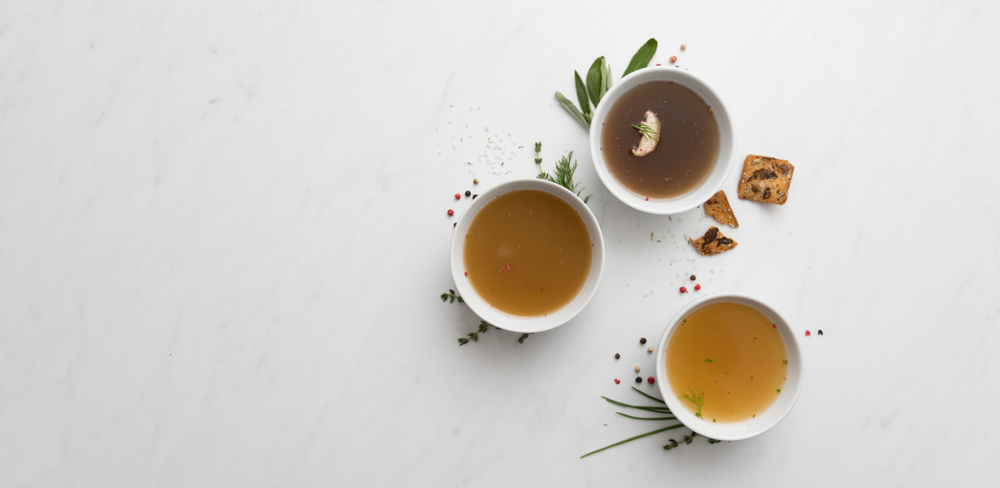Article by Dr Sarah Lantz
When the temperature dips, broths, bouillons and soups make a bold and grand entrance. Few traditional foods are as beloved and comforting as broth. Flavoursome, fragrant, and gelatinous, bone broths are known to soothe the gut, heal joints, and deeply nourish. Made from meat and fish bones, vegetables and herbs, broths have been used as a homemade remedy across centuries and cultures.
Our hunter-gatherer ancestors made bone broth out of necessity. They ate from nose to tail, hooves and bones, guts and skin, mastering the art of making every part of the animal count. Then they used all the things they couldn’t eat – like hides – to make shelters, clothing, weapons and tools. Broths, stocks, soups, stews and sauces are a continuation of this tradition and have earned a well-loved and much deserved place in kitchens throughout the world. While there are many places to purchase pre-made broths in the stores and online, homemade broth is easy.
Equipment
If cooking on stovetop, use a large stainless-steel stock pot (so as to not have any other material leaching into your broth) or a slow cooker. Make sure you have a good lid to cover the surface that will ultimately allow the condensation fall back into your broth.
A gas stove offers a little more temperature control and will generally produce a better result; however, broth must simmer for a long time, so you may not feel comfortable to leave your brew for 24–48 hours on an open flame. Always consider safety first. The easiest solution is to use a slow cooker. A second option is to simmer the stock in stages, turning it off when unattended and back on when you’re around to watch it. Sometimes people burn their stockpot. This usually happens when attention to the level of their water wavers. In this case, always watch your water level and add more water if needed.
Temperature
Slow and steady is essential for a good broth. This is the key to ensure a full-bodied, gelatinous broth. You want to maintain a low, consistent simmer temperature. Too high a temperature will make your broth ‘dirty’ and destroy the collagen that forms the gelatine.
Cooking time
When you achieve the right simmer temperature, the bones must sit in the liquid for an extended period of time. Chicken broth will take 12–24 hours, while beef will take 24–48 hours (even 72 hours if you have the time). If you cut short the simmering process, your broth may not have enough time for the gelatine, along with other nutrients, to be extracted from the bones.
Water levels
The water level is the key to a good jelly-like consistency. If there is too much water and not enough bones, your broth will stay liquid. The key is to just cover the bones with water. Opt for less water rather than more; you can always dilute your broth at the end if you need to, but you can’t add extra bones.
Bone quality
Chicken carcasses alone often don’t offer enough gelatine, and it is therefore better to add feet and necks if you can find some. Otherwise, chicken wings are a good alternative. If you are using a chicken that was cooked beforehand, that’s fine, but just be aware that you will have the flavours of whatever you cooked it with in your broth. With a roast chicken, eat the meat and then use the carcasses for your broth. If you like, you can freeze the carcass first; when you are ready to make your broth, just pop it into your pot.
Beef bones should come from a combination of joint bones, marrow bones, ribs and neck bones to get the best broth results. It’s important that you use organic grass-fed bones, because your broth will absorb any industrial and consumer chemicals the animal has been exposed to.
Should I roast the bones first?
This is completely optional. Browning the bones will add more flavour and improve the colour. But it is an extra step (around 40 minutes) and you will lose some of the benefits of the bone broth – the marrow will melt into your oven pan and you will lose some good fat.
What do I do with the fat on top?
The fat is good to keep; you can leave it as is and drink it with your broth, or skim it off the surface and use it as a cooking fat, the way you would use ghee. The fat has absorbed all the minerals during cooking time, so it is nutrient dense. The fat also has an exceptional flavour and a high smoke point, so it is much safer to cook with than vegetable oils.
What do I do with the meat and veg of the broth?
Eat them. They are full of nutrients; the meat will be tender and veggies soft. Blend them up to a puree for baby food. Pets love them, too.
Can I reuse bones?
Large bones can be re-used. They will make a weaker and less nutritious broth the next time you use them. Bones need to go straight into a freezer, as once they hit room temperature, bones can become a nasty bacterial breeding ground within seconds. It’s important to store them correctly.
Can I use veggie scraps in my broth?
Definitely! Keep any carrot bottoms, head and tails of onions, celery bases or whatever else you have. Freeze them, then put them straight in your pot when you are ready to make a broth.
Recipes
Try these simple recipes at home using organic ingredients to make the perfect broth!
Satisfying Beef Bone Broth
Chicken Broth (soup)
Vegetable Broth
By:
Dr Sarah Lantz (PhD)
Buchi Brew Co. & Sacred Women’s Way


